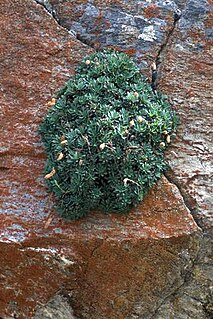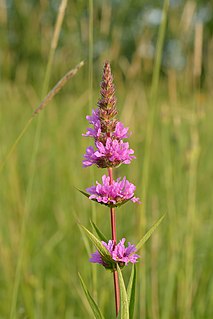
Lythrum salicaria, or purple loosestrife, is a flowering plant belonging to the family Lythraceae. It should not be confused with other plants sharing the name loosestrife that are members of the family Primulaceae. Other names include spiked loosestrife and purple lythrum.

Spiraea ,, sometimes spelled spirea in common names, is a genus of about 80 to 100 species of shrubs in the family Rosaceae. They are native to the temperate Northern Hemisphere, with the greatest diversity in eastern Asia.

Spiraea tomentosa, commonly known as the steeplebush, meadowsweet, or hardhack, is a plant similar in characteristics to S. douglasii.

Spiraea douglasii is a species of flowering plant in the rose family native to western North America. Common names include hardhack, hardhack steeplebush, Douglas' spirea, douglasspirea, steeplebush, and rose spirea.

Spiraea prunifolia, commonly called bridalwreath spirea, is a species of the genus Spiraea, sometimes also spelled Spirea. It flowers mid-spring, around May 5th, and is native to Japan, Korea, and China. It is sometimes cultivated as a garden plant elsewhere.
Lobelia oligophylla is an ornamental plant in the Campanulaceae family. It can be found from Ecuadorean Andes to Tierra del Fuego, in moist, usually open places. It was one of the species recorded and collected on Charles Darwin's The Voyage of the Beagle in the 1830s. It was previously known as Hypsela reniformis, but because the genus Hypsela is part of the enlarged genus Lobelia it had to be transferred. Its epithet changed because the name Lobelia reniformis was not available for it, as it was already in use for another species. The name Lobelia oligophylla was therefore reinstated.
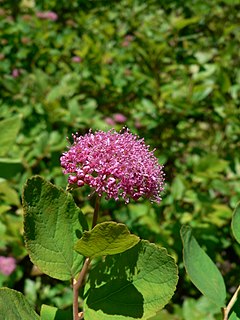
Spiraea splendens is a shrub of the rose family (Rosaceae) native to the western mountains of North America, from California to British Columbia, commonly known as dense-flowered spiraea, rose meadowsweet, rosy spiraea, subalpine spiraea, and mountain spiraea. It is commonly found at elevations between 2,000 and 11,000 feet on inland mountain ranges. The plant is adapted to cold, moist, rocky slopes, subalpine forests and meadows.

Spiraea japonica, the Japanese meadowsweet, Japanese spiraea, or Korean spiraea, is a plant in the family Rosaceae. Synonyms for the species name are Spiraea bumalda Burv. and Spiraea japonica var. alpina Maxim.

Spiraea thunbergii (珍珠绣线菊), Thunberg spiraea or Thunberg's meadowsweet, is a species of flowering plant in the rose family, native to East China and Japan, and widely cultivated elsewhere.
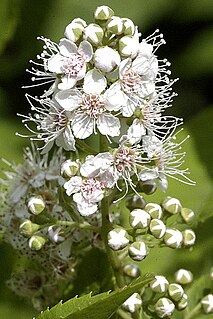
Spiraea alba, commonly known as meadowsweet, white meadowsweet, narrowleaf meadowsweet, pale bridewort, or pipestem, is native to the wet soils of the Allegheny Mountains and other portions of eastern North America, but is currently endangered in the state of Missouri. It is naturalized in other parts of the world.

Astragalus cremnophylax is a rare species of milkvetch known by the common names sentry milkvetch and cliff milkvetch. It is endemic to Arizona, where the three varieties grow in three separate locations. The rarest variety, var. cremnophylax, is a federally listed endangered species which grows only on the rim of the Grand Canyon. The two other varieties are known from the Buckskin Mountains and Marble Canyon.
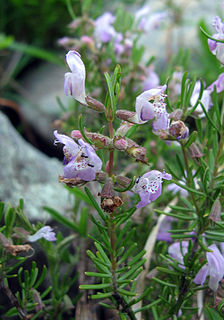
Conradina verticillata is a species of flowering plant in the mint family known by the common names Cumberland rosemary, or Cumberland false rosemary, and upland rabbitbane. It is endemic to the Cumberland Plateau in the United States, where it occurs along the tributaries of the Cumberland River and the Tennessee River in Kentucky and Tennessee. It is known from several occurrences which are mostly small and often degraded in quality. Because many occurrences of the plant are threatened by numerous processes, the plant is federally listed as threatened.
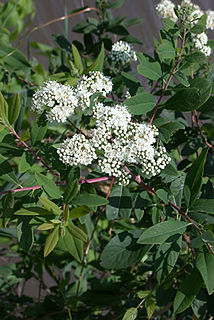
Spiraea virginiana is a rare species of flowering plant in the rose family (Rosaceae) known by the common names Virginia meadowsweet and Virginia spiraea. It is native to the southern Appalachian Mountains, where it has a distribution scattered across nine states. However, most populations are very small and poor in quality. It is threatened by disturbances in the hydrology of its habitat, introduced species of plants, and other threats. It is a federally listed threatened species of the United States.
Viola frank-smithii is a rare species of violet known by the common name Frank Smith's violet. It is endemic to Utah in the United States, where it is known only from Logan Canyon in the Bear River Range in Cache County.

Spiraea nipponica is a species of flowering plant in the family Rosaceae, native to the island of Shikoku, Japan. Growing to 1.2–2.5 m (4–8 ft) tall and broad, it is a deciduous shrub with clusters of small, bowl-shaped white flowers in midsummer.

Spiraea chamaedryfolia, common name germander meadowsweet or elm-leaved spirea, is a species of plants belonging to the family Rosaceae.
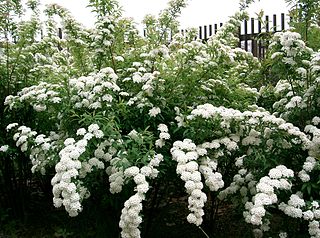
Spiraea cantoniensis, also known as, Reeve's spiraea, Bridalwreath spirea, Double White May, Cape May or May Bush, is a species of plant native to China, belonging to the family Rosaceae. An ornamental plant featured in gardens, it is a shrub growing up to 1.5 metres (4.9 ft) tall with frothy, pompom-like clusters of snow-white flowers borne along arching branches that bloom in May in its native country, hence its common name.




